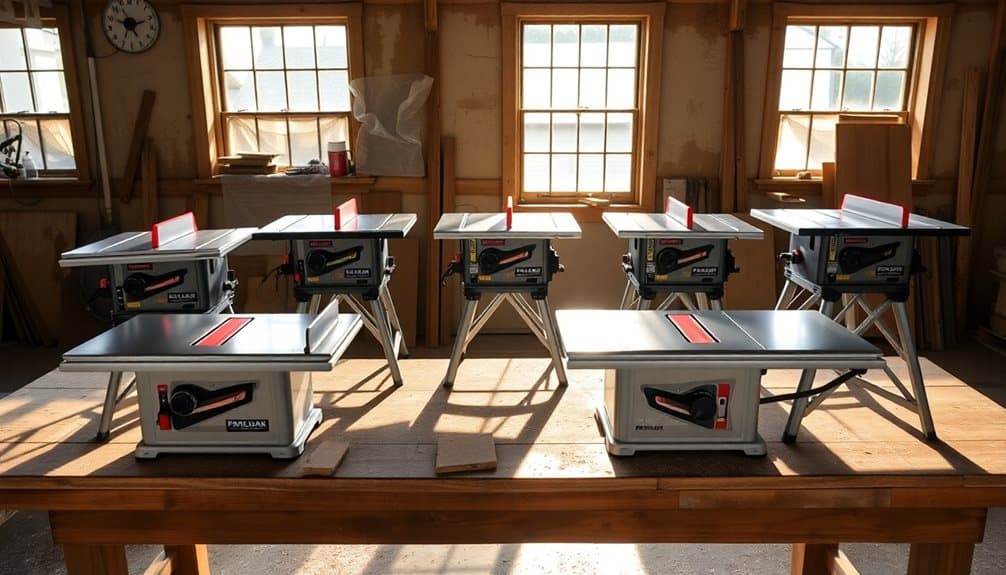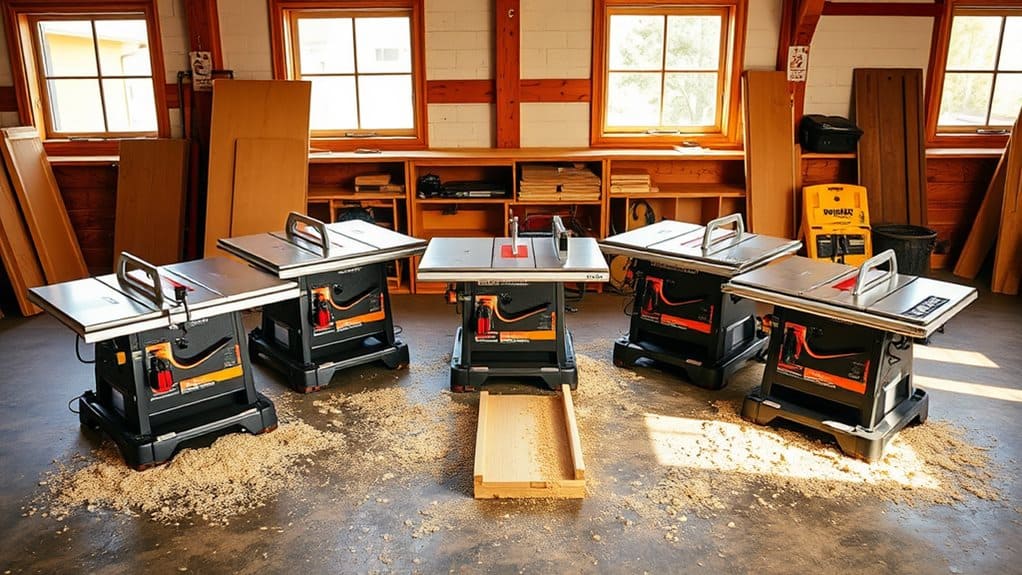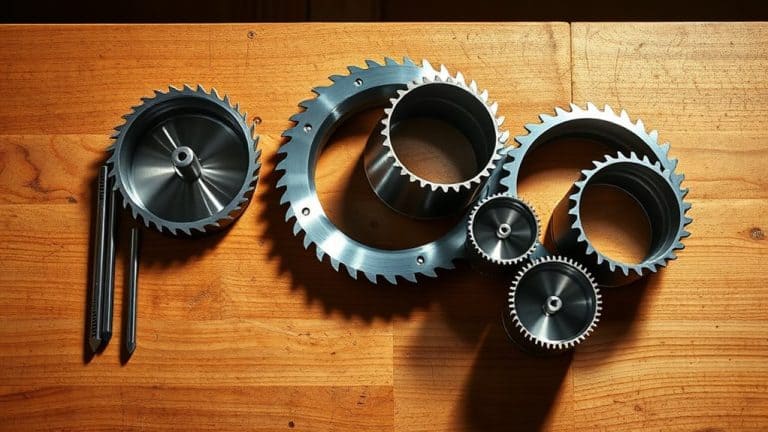This website contains affiliate links. Some products are gifted by the brand to test. As an Amazon Associate, I earn from qualifying purchases. The content on this website was created with the help of AI.
Among today’s top portable table saws, you’ll find the DEWALT DWE7485 leading the pack with its professional-grade 8-1/4 inch blade and efficient dust collection. The SKIL TS6307-00 offers excellent value with its lightweight design and integrated stand. For heavy-duty work, consider the DEWALT DWE7491RS with its impressive 32-1/2 inch rip capacity, while the SKIL SPT99-11 features robust worm drive gearing for demanding jobs. The BOSCH GTS15-10 rounds out the top five with its powerful 4 HP motor and wheeled stand. Let’s explore how these saws can transform your woodworking projects with their unique features and capabilities.
Key Takeaways
- DEWALT DWE7491RS ranks as the top choice for its powerful 15-amp motor, excellent 32-1/2 inch rip capacity, and reliable Rack & Pinion system.
- SKIL TS6307-00 offers the best value with its lightweight design, integrated folding stand, and 10-inch blade capacity for 4×4 materials.
- DEWALT DWE7485 excels in compact spaces with its 8-1/4 inch blade and superior dust collection, capturing 90% of sawdust.
- SKIL SPT99-11 stands out for heavy-duty work with its Dual-Field Motor, robust worm drive gearing, and sturdy rolling stand.
- BOSCH GTS15-10 delivers professional performance with 4 HP motor power, extensive rip capacity, and convenient Gravity-Rise Wheeled Stand.
DEWALT Table Saw for Jobsites, 8-1/4 Inch, 15 Amp (DWE7485)
- 24.5 in. of rip capacity for ripping 4x8 plywood or OSB sheets
- Compact size for easy transportation and storage
- Rack & pinion telescoping fence rails make fence adjustments fast, smooth, and accurate
The DEWALT DWE7485 stands out as the ideal choice for contractors and DIY enthusiasts who need professional-grade cutting power in a compact package. With its 15-amp motor and 8-1/4-inch blade, you’ll get impressive cutting capabilities while maintaining portability.
You’ll appreciate the saw’s extensive features, including an efficient fence system for precise cuts, adjustable bevel settings, and integrated storage for your blade tools and push stick. The modular guard system offers clear visibility during cuts, and the dust collection port captures up to 90% of sawdust when connected to a standard wet/dry vacuum.
While the tabletop size might be smaller than larger models, you’ll find it’s a worthwhile trade-off for its mobility. The saw’s ability to handle 4×8 sheets and its quick setup make it particularly valuable for jobsite work or space-conscious workshops.
Best For: Professional contractors and DIY enthusiasts seeking a powerful, portable table saw that balances cutting capability with compact design and easy transport.
Pros:
- Compact and lightweight design makes it highly portable while maintaining professional-grade cutting power
- Efficient dust collection system captures 90% of sawdust when properly connected to a vacuum
- Comprehensive package includes all essential accessories and features integrated storage solutions
Cons:
- Smaller table top size compared to full-sized table saws may limit some larger project capabilities
- Start button placement could be more convenient for some users
- 8-1/4 inch blade size might not be suitable for extremely deep cuts that require larger blades
SKIL Portable Jobsite Table Saw with Folding Stand (TS6307-00)
- RACK AND PINION FENCE RAILS - Ensures fence stays parallel to blade for fast smooth, and accurate cuts
- INTEGRATED FOLDING STAND - Legs quickly fold in to provide portability and convenient storage
- PARALLEL BLADE ALIGNMENT - Available micro-adjustment of blade so that it is parallel to rip fence and miter slot
Budget-conscious DIY enthusiasts and intermediate woodworkers will find exceptional value in SKIL’s TS6307-00 portable table saw. With its 15-amp motor and 10-inch blade, you’ll be able to tackle 4×4 materials at 90 degrees and make precise bevel cuts at 0 and 45 degrees.
You’ll appreciate the integrated folding stand that makes transport and storage a breeze, while the rack and pinion fence rails guarantee your cuts are smooth and accurate. At 51.15 pounds, it’s lightweight enough to move around your workspace, yet sturdy enough for reliable performance. The parallel blade alignment system lets you make micro-adjustments for precise cuts, and the dust port elbow helps keep your work area clean. With a 25-1/2-inch rip capacity and included safety features like an anti-restart switch, you’re getting professional-grade capabilities at a budget-friendly price point.
Best For: DIY enthusiasts and intermediate woodworkers seeking a portable, reliable table saw with professional features at an affordable price point.
Pros:
- Excellent portability with integrated folding stand and lightweight design at 51.15 lbs
- Precise cutting capability with rack and pinion fence system and parallel blade alignment
- Strong 15-amp motor capable of handling 4×4 materials with 25-1/2″ rip capacity
Cons:
- Limited options for aftermarket throat plates
- Some users report concerns about throat plate material quality
- May not be powerful enough for heavy-duty professional use or constant operation
DEWALT DWE7491RS 10-Inch Table Saw
- Rack & Pinion Telescoping Fence System Make fence adjustments fast, smooth and accurate
- Patented material support, can be used for narrow rip cuts.
- 32-1/2" rip capacity easily cuts a variety of larger shelving and trim materials
Professional contractors and dedicated woodworkers seeking versatility will find their match in DEWALT’s DWE7491RS 10-inch table saw. With its 32-1/2-inch rip capacity and powerful 15-amp motor running at 4800 RPM, you’ll easily handle large sheet materials and demanding cuts.
The saw’s standout feature is its Rack & Pinion Telescoping Fence System, ensuring precise, smooth adjustments every time. You’ll appreciate the rolling stand‘s easy setup and breakdown, making it ideal for jobsite mobility despite its 110-pound weight. The 2-inch dust collection port keeps your workspace clean, while onboard storage provides quick access to all accessories. Whether you’re installing cabinets, laying hardwood floors, or building decks, this saw delivers professional-grade results. The 3-1/8-inch cut depth at 90 degrees handles most common cutting tasks, while the 3-year warranty provides peace of mind.
Best For: Professional contractors, cabinet installers, and serious woodworkers who need a powerful, portable table saw with excellent rip capacity for both jobsite and workshop use.
Pros:
- Outstanding 32-1/2 inch rip capacity handles large materials with ease
- Rack & Pinion Telescoping Fence System provides precise, reliable adjustments
- Rolling stand with easy setup/breakdown enhances portability despite hefty weight
Cons:
- Heavy 110-pound weight may be challenging for solo transport
- Lacks advanced safety features like SawStop technology
- Premium price point compared to basic contractor table saws
SKIL 10 Inch Heavy Duty Worm Drive Table Saw with Stand – SPT99-11
- Legendary worm drive gearing with 3-5/8 inch depth of cut and 30-1/2 inch rip capacity
- Precision rack and pinion fence system makes fence adjustments quickly and smoothly for accurate cuts
- Rugged rolling stand with 16 inch Wheels and easy-load handles delivers unsurpassed mobility
Boasting legendary worm drive gearing and a robust design, SKIL’s SPT99-11 stands out as an ideal choice for contractors who need reliability on and off the jobsite. You’ll appreciate its 3-5/8 inch depth of cut and generous 30-1/2 inch rip capacity, powered by a Dual-Field™ Motor that runs cooler for extended performance.
The saw’s rugged rolling stand with 16-inch wheels makes it easy to navigate rough terrain and stairs, while the precision rack and pinion fence system guarantees accurate cuts every time. At 100 pounds, you’ll find it manageable to transport solo, and the folding stand provides stability during use. The safety switch and dust port elbow enhance your work experience, while the blade bevel adjustment via twist compression handle offers quick setup changes. For best results, you might want to upgrade to a premium blade for furniture-grade cuts.
Best For: Professional contractors and serious DIY woodworkers who need a powerful, portable table saw capable of handling heavy-duty cutting tasks on various job sites.
Pros:
- Robust worm drive gearing and Dual-Field™ Motor provide exceptional power and durability for demanding cuts
- Superior mobility with 16-inch wheels and folding stand makes it easy to transport across rough terrain
- Precise rack and pinion fence system ensures accurate cuts and easy adjustments
Cons:
- Heavy weight at 100 pounds may be challenging for some users to transport
- Stock blade may need upgrading for furniture-grade cuts
- Higher price point compared to standard contractor table saws
BOSCH GTS15-10 Portable Jobsite Table Saw with Wheeled Stand
- 15-Amp saw with 3,800 rpm for rip-cutting and cross-cutting of fine and hard wood materials
- CONVENIENCE BRAKE: Helps blade stop in approximately three seconds, increasing productivity
- CLAMPZONE AREAS :Allow tabletop to be used as a light-duty, secondary work surface
Serious woodworkers who don’t mind investing time in setup will find the Bosch GTS15-10’s power impressive, thanks to its 15-amp motor delivering 4 HP at 3,800 rpm. You’ll appreciate the saw’s 32-1/8 inch rip capacity and its ability to cut 4×4 material in one pass while handling dado stacks.
However, you’ll need to address several quality concerns before achieving peak performance. The blade, fence, and miter gauge require adjustments out of the box, and the loose-fitting table insert tends to rattle. While the included GTA50W Gravity-Rise Wheeled Stand enhances portability, the fence rails and end caps’ thin plastic construction might not withstand jobsite abuse. The convenience brake stops the blade in three seconds, and the dust collection system works well with a standard 2-1/2″ vacuum hose, but these features don’t fully compensate for the underwhelming build quality.
Best For: Professional woodworkers and serious DIYers who have the patience to tune and adjust their saw and prioritize power and portability over out-of-the-box precision.
Pros:
- Powerful 15-amp motor with 4 HP and 3,800 rpm for handling tough materials
- Large 32-1/8 inch rip capacity with ability to cut 4×4 lumber in one pass
- Portable design with wheeled stand and effective dust collection system
Cons:
- Significant initial setup and adjustments required for accurate performance
- Poor build quality with plastic components and loose-fitting table insert
- Underwhelming miter gauge and fence system requiring modifications for stability
Factors to Consider When Choosing Portable Tablesaws

When you’re shopping for a portable table saw, you’ll need to weigh several critical factors that affect both performance and usability. Your decision should focus on the blade size and power output for your typical cutting needs, the unit’s weight and built-in portability features, rip capacity for your common materials, and the effectiveness of safety mechanisms like riving knives and blade guards. The saw’s stand design and storage options are equally important, as they’ll determine how easily you can transport and set up your saw at different work sites.
Blade Size and Power
Two critical factors that’ll make or break your portable table saw experience are blade size and power. When you’re looking at blade size, you’ll want to focus on the cutting capacity you need for your projects. A 10-inch blade offers greater versatility and deeper cuts, making it ideal if you’ll be working with larger workpieces or need to rip wider sheets of plywood.
Your saw’s motor power directly impacts its performance during tough cuts. You’ll want to look for a 15-amp motor, which has become the standard for portable table saws. This power rating guarantees you won’t experience frustrating stalls or slowdowns when cutting through hardwoods or thick materials.
Consider how blade size and motor power work together. A powerful motor paired with the right blade size lets you tackle demanding cuts without compromising speed or quality. You’ll also want to invest in carbide-tipped blades, as they’ll give you cleaner cuts and last longer than standard blades. Remember that the right combination of blade size and power doesn’t just affect cutting capacity – it determines the overall efficiency and versatility of your portable table saw.
Weight and Portability Features
Successful portable table saw selection hinges heavily on weight and portability features, with models ranging from 51 to 110 pounds. When you’re moving between job sites frequently, you’ll want to prioritize lighter models that don’t compromise on stability. The lower end of this weight range usually offers easier transport while still maintaining essential cutting capabilities.
Look for saws with integrated or folding stands, as these designs considerably improve your setup and breakdown efficiency. Models equipped with large wheels are particularly valuable if you’re working across varied terrain or need to navigate stairs. You’ll find that wheel-equipped stands can transform a challenging transport task into a manageable one.
When evaluating portability, don’t overlook storage considerations. You’ll want a saw that collapses into a compact form, especially if you’re working with limited space in your vehicle or workshop. Pay close attention to the saw’s center of gravity and weight distribution – these factors directly impact stability during operation. The best portable table saws combine a low center of gravity with thoughtful weight distribution to prevent tipping while still maintaining mobility when you need to relocate.
Rip Capacity Needs
Beyond a saw’s mobility features, rip capacity stands as a fundamental factor that’ll shape your cutting capabilities. When selecting a portable table saw, you’ll want to verify it can handle the materials you regularly work with. For standard 4×8 plywood sheets, you’ll need a saw with at least 25 inches of rip capacity to make efficient cuts without requiring additional support systems.
Consider the types of projects you typically tackle and the materials you use most often. If you’re working primarily with smaller pieces or dimensional lumber, a more modest rip capacity might suffice. However, if your projects frequently involve larger sheets or wide boards, you’ll want to prioritize models with greater rip capacities. This versatility will allow you to handle a broader range of cutting tasks without limitations.
Before making your final decision, carefully review the rip capacity specifications of each model you’re considering. Don’t just focus on the saw’s portability features – make certain it can accommodate the maximum width of materials you’ll need to cut. This foresight will help prevent frustrating limitations in your future woodworking projects.
Safety Mechanism Design
When evaluating portable table saws, safety mechanisms should be at the forefront of your decision-making process. Modern table saws come equipped with multiple safety features that can greatly reduce the risk of accidents and injuries during operation.
Look for models with anti-restart switches, which prevent the saw from automatically starting up after a power interruption. This feature is vital if you’re working in areas with unstable power supply. You’ll also want to verify the saw has a riving knife, as this component helps prevent dangerous kickback by keeping the cut material from pinching the blade.
Pay attention to the blade guard design – transparent guards offer the best visibility while maintaining protection. They’ll let you clearly see your cutting line and monitor blade position throughout operation. Don’t overlook the importance of deliberate-action safety switches, which require specific engagement to start the saw.
Stand and Storage Options
A well-designed stand and storage system complements your table saw’s safety features by ensuring stability during operation. When assessing portable table saws, you’ll want to focus on models that offer integrated stands, which provide both convenience and reliability during setup and transport.
Look for folding stands that can collapse quickly for storage and transport while maintaining structural integrity when deployed. You’ll find that models with robust wheels or casters make a significant difference, especially when you’re moving the saw across workshop floors or job sites with uneven surfaces.
Your storage needs shouldn’t be an afterthought. Select a table saw that includes built-in storage compartments within the stand design. These spaces keep your blades, wrenches, and other accessories organized and readily available when you need them. You won’t waste time searching for essential tools during a project.
Weight is another important aspect to take into account. While you want a sturdy machine, excessive weight can make transport challenging. The best portable table saws strike a balance between mobility and stability, offering a lightweight design that doesn’t compromise performance or safety during operation.
Dust Collection Efficiency
Dust management stands as a critical factor in your portable table saw selection, directly impacting both workspace safety and cleanup efficiency. When you’re evaluating different models, you’ll want to look for saws that can capture around 90% of sawdust through their collection systems, as this greatly reduces your cleanup time and maintains a safer working environment.
Pay attention to the saw’s dust port design and compatibility with standard shop vacuum hoses. You’ll find that models with enclosed frames typically perform better at dust collection than those with open designs, as they’re better at directing debris to the collection point. Look for features like integrated dust chutes and collection bags, which can make a considerable difference in managing sawdust during operation.
Consider how the dust collection system affects your visibility while cutting. An effective system won’t just keep your workspace clean—it’ll help protect your respiratory health and maintain clear sight lines during operation. You’ll want to examine how each saw’s dust management features work together, as some models offer superior collection efficiency through a combination of enclosed housing, well-designed ports, and integrated collection systems.
Price Vs Build Quality
Through careful evaluation of portable table saws, you’ll find that price and build quality share a direct relationship that greatly impacts your long-term satisfaction. While it’s tempting to opt for budget-friendly models, you’ll need to take into account how build quality affects your work efficiency and overall costs.
Higher-priced portable table saws typically feature premium materials and superior construction, offering better fence systems and more reliable components. You’ll notice these quality differences in daily operation, as premium models provide smoother cuts, more stable setups, and easier transportation between job sites. The enhanced build quality translates to consistent performance and fewer adjustments.
When you choose a lower-priced model, you’re often sacrificing durability and precision. You’ll likely encounter more frequent maintenance needs, component replacements, and accuracy issues that can waste materials and time. These hidden costs can quickly exceed the initial savings from choosing a cheaper saw. Instead, take into account your table saw as a long-term investment – spending more upfront on a well-built model will reward you with better cutting accuracy, improved efficiency, and reduced maintenance expenses over the tool’s lifetime.
Fence System Accuracy
Precise fence system accuracy stands as one of the most critical features you’ll need to assess when selecting a portable table saw. You’ll want to look for models equipped with rack and pinion fence systems, which deliver smooth, consistent adjustments while maintaining perfect alignment with the blade. These systems prove especially valuable when you’re ripping wide materials like plywood or dimensional lumber.
When examining fence systems, you’ll need to focus on two key aspects: micro-adjustment capabilities and locking mechanisms. The best portable table saws offer precise micro-adjustment features that let you fine-tune the fence position down to fractions of an inch, ensuring your cuts match your exact specifications. The fence’s locking mechanism should engage firmly and maintain its position throughout your cutting operation, preventing any unwanted movement that could compromise accuracy.
Don’t forget to evaluate the fence system’s compatibility with accessories you might need. If you’re planning to use dado blades or specialized cutting tools, make sure the fence can accommodate these additions without sacrificing accuracy or stability. This versatility will extend your saw’s capabilities while maintaining the precision you need for professional-quality results.
Frequently Asked Questions
Can Portable Table Saws Cut Hardwoods Like Oak and Maple Effectively?
Yes, you’ll find that portable table saws can be quite the workhorses when it comes to hardwoods. While they’re not as brawny as their stationary cousins, today’s portable saws pack enough punch to handle oak and maple effectively. You’ll want to use sharp blades and take slightly slower feed rates. For best results, opt for a saw with at least 15 amps and make certain you’re using the right blade for hardwood cutting.
What Safety Gear Should I Wear When Operating a Portable Table Saw?
When operating a portable table saw, you’ll need several essential safety items. Always wear safety glasses or goggles to protect your eyes from flying debris. Use ear protection like earmuffs or earplugs to guard against loud noise. Don’t forget close-toed shoes and avoid loose clothing that could get caught. Push sticks and featherboards are must-have accessories. Finally, wear a dust mask to protect your lungs from wood particles.
How Often Should I Replace the Blade on My Portable Table Saw?
You’ll need to replace your table saw blade when you notice signs of wear, typically every 12-18 months with regular use. Watch for these indicators: dull teeth, burn marks on wood, increased resistance while cutting, or unusual noise during operation. If you’re using your saw daily, you might need to replace the blade more frequently. For the best performance, don’t wait until the blade is completely worn out before replacing it.
Are Battery-Powered Portable Table Saws as Powerful as Corded Models?
Like comparing a lion to a house cat, battery-powered table saws typically don’t match the raw power of their corded cousins. While cordless models have improved considerably, you’ll notice they’re generally less powerful, offering around 15-20% less cutting force. However, if you’re mainly doing light to medium-duty work, today’s battery-powered saws can handle most jobs effectively. They’re perfect when you need mobility and don’t have easy access to power outlets.
Can I Use Dado Blades With These Portable Table Saws?
You’ll need to be careful with dado blades on portable table saws, as most models aren’t designed to accommodate them. The arbor length is typically too short, and the motor may not have enough power to safely cut dados. If you’re planning to make dado cuts, you’ll want to check your saw’s manual first – some manufacturers specifically warn against using dado blades for safety and warranty reasons.









